In Vitro Insights into the Antifungal, Prebiotic, and Cytotoxic Potential of Tomato Plant Waste
Abstract
1. Introduction
2. Materials and Methods
2.1. Developing the Novel Prebiotic Formulation of Tomato Plant Waste Extracts
2.2. Phytochemical Profiles of the Tomato Plant Waste Extracts
2.2.1. Assessment of GC-MS Volatile and Semi-Volatile Profile
2.2.2. Assessment of FTIR Phytochemical Profile
2.2.3. Assessment of the HPLC Soluble Sugar Profile
2.2.4. Assessment of the LC-MS/MS Glycoalkaloids Profile
2.3. In Vitro Biological Effects of the Tomato Plant Waste Extracts
2.3.1. Assessment of the Antifungal Effect Using the Disk Diffusion Assay
2.3.2. Assessment of the Antifungal Effect Using the Microdilution Assay
2.3.3. Assessment of the Prebiotic Effect Using the Growth Curve Kinetics Assay
2.3.4. Assessment of the Cytotoxicity Effect Using In Vitro Assay
2.4. Statistical Analysis
3. Results
3.1. Phytochemical Profiles of the Tomato Plant Waste Extracts
3.1.1. GC-MS Volatile and Semi-Volatile Profile
3.1.2. FTIR Phytochemical Profile
3.1.3. HPLC Soluble Sugar Profile
3.1.4. LC-MS/MS Glycoalkaloids Profile
3.2. Positive In Vitro Biological Effects of the Tomato Plant Extracts
3.2.1. Antifungal Effect Using Disk Diffusion Assay
3.2.2. Antifungal Effect Using the Microdilution Assay
3.2.3. Prebiotic Effect Using the Growth Curve Kinetics Assay
3.2.4. Cytotoxicity Effect Using In Vitro Assay
4. Discussion
5. Conclusions
Author Contributions
Funding
Institutional Review Board Statement
Informed Consent Statement
Data Availability Statement
Acknowledgments
Conflicts of Interest
References
- Singh, R.; Das, R.; Sangwan, S.; Rohatgi, B.; Khanam, R.; Peera, S.K.P.G.; Das, S.; Lyngdoh, Y.A.; Langyan, S.; Shukla, A.; et al. Utilisation of agro-industrial waste for sustainable green production: A review. Environ. Sustain. 2021, 4, 619–636. [Google Scholar] [CrossRef]
- Mitri, S.; Koubaa, M.; Maroun, R.G.; Rossignol, T.; Nicaud, J.M.; Louka, N. Bioproduction of 2-Phenylethanol through Yeast Fermentation on Synthetic Media and on Agro-Industrial Waste and By-Products: A Review. Foods 2022, 11, 109. [Google Scholar] [CrossRef]
- Prado-Acebo, I.; Cubero-Cardoso, J.; Lu-Chau, T.A.; Eibes, G. Integral multi-valorization of agro-industrial wastes: A review. Waste Manag. 2024, 183, 42–52. [Google Scholar] [CrossRef]
- Ćetković, G.; Savatović, S.; Čanadanović-Brunet, J.; Djilas, S.; Vulić, J.; Mandić, A.; Četojević-Simin, D. Valorisation of phenolic composition, antioxidant and cell growth activities of tomato waste. Food Chem. 2012, 133, 938–945. [Google Scholar] [CrossRef]
- Strati, I.F.; Oreopoulou, V. Recovery of carotenoids from tomato processing by-products—A review. Food Res. Int. 2014, 65, 311–321. [Google Scholar] [CrossRef]
- Coelho, M.C.; Rodrigues, A.S.; Teixeira, J.A.; Pintado, M.E. Integral valorisation of tomato by-products towards bioactive compounds recovery: Human health benefits. Food Chem. 2023, 410, 135319. [Google Scholar] [CrossRef] [PubMed]
- Luo, Z.; Janssen, B.J.; Snowden, K.C. The molecular and genetic regulation of shoot branching. Plant Physiol. 2021, 187, 1033. [Google Scholar] [CrossRef] [PubMed]
- Chauhan, S.; Pandit, N.K.; Mohanty, A.; Meena, S.S. Resource recovery of bioactive compounds from food waste and their diverse industrial applications. Biomass Conv. Bioref. 2023, 15, 27941–27961. [Google Scholar] [CrossRef]
- Masood, A.; Hassan, B.; Azhar, F.; Khan, G.R. Food waste as a useful resource of Bioactive compounds and their Extraction. Pak. J. Chem. 2023, 13, 88–91. [Google Scholar] [CrossRef]
- Siddique, F.; Ali, Z.; Arshad, M.; Mubeen, K.; Ghazala, A. Exploration of novel eco-friendly techniques to utilize bioactive compounds from household food waste: Special reference to food applications. Front. Food Sci. Technol. 2024, 4, 1388461. [Google Scholar] [CrossRef]
- Yadav, S.; Malik, K.; Moore, J.M.; Kamboj, B.R.; Malik, S.; Malik, V.K.; Arya, S.; Singh, K.; Mahanta, S.; Bishnoi, D.K. Valorisation of Agri-Food Waste for Bioactive Compounds: Recent Trends and Future Sustainable Challenges. Molecules 2024, 29, 2055. [Google Scholar] [CrossRef]
- Liu, Y.; Hu, H.; Yang, R.; Zhu, Z.; Cheng, K. Current Advances in the Biosynthesis, Metabolism, and Transcriptional Regulation of α-Tomatine in Tomato. Plants 2023, 12, 3289. [Google Scholar] [CrossRef]
- Patel, A.H.; Sharma, H.P.; Vaishali. Physiological functions, pharmacological aspects and nutritional importance of green tomato- a future food. Crit. Rev. Food Sci. Nutr. 2024, 64, 9711–9739. [Google Scholar] [CrossRef]
- Ali, M.Y.; Sina, A.A.I.; Khandker, S.S.; Neesa, L.; Tanvir, E.M.; Kabir, A.; Khalil, M.I.; Gan, S.H. Nutritional Composition and Bioactive Compounds in Tomatoes and Their Impact on Human Health and Disease: A Review. Foods 2021, 10, 45. [Google Scholar] [CrossRef] [PubMed]
- Rodríguez-Espinosa, T.; Voukkali, I.; Pérez-Gimeno, A.; Almendro Candel, M.B.; Hernández-Martich, J.D.; Zorpas, A.A.; Lucas, I.G.; Navarro-Pedreño, J. Waste as a Sustainable Source of Nutrients for Plants and Humans: A Strategy to Reduce Hidden Hunger. Sustainability 2024, 16, 7185. [Google Scholar] [CrossRef]
- Poria, V.; Rana, A.; Kumari, A.; Grewal, J.; Pranaw, K.; Singh, S. Current Perspectives on Chitinolytic Enzymes and Their Agro-Industrial Applications. Biology 2021, 10, 1319. [Google Scholar] [CrossRef] [PubMed]
- Pereira, N.; Farrokhi, M.; Vida, M.; Lageiro, M.; Ramos, A.C.; Vieira, M.C.; Alegria, C.; Gonçalves, E.M.; Abreu, M. Valorisation of Wasted Immature Tomato to Innovative Fermented Functional Foods. Foods 2023, 12, 1532. [Google Scholar] [CrossRef]
- Coelho, M.C.; Costa, C.; Roupar, D.; Silva, S.; Rodrigues, A.S.; Teixeira, J.A.; Pintado, M.E. Modulation of the Gut Microbiota by Tomato Flours Obtained after Conventional and Ohmic Heating Extraction and Its Prebiotic Properties. Foods 2023, 12, 1920. [Google Scholar] [CrossRef]
- Marcu Spinu, S.; Dragoi Cudalbeanu, M.; Major, N.; Goreta Ban, S.; Palčić, I.; Ortan, A.; Rosu, P.M.; Babeanu, N.E. Box–Behnken Design Optimization of Green Extraction from Tomato Aerial Parts and Axillary Shoots for Enhanced Recovery of Rutin and Complementary Bioactive Compounds. Antioxidants 2025, 14, 1062. [Google Scholar] [CrossRef]
- Mukhamedsadykova, A.Z.; Kasela, M.; Kozhanova, K.K.; Sakipova, Z.B.; Kukuła-Koch, W.; Józefczyk, A.; Świątek, Ł.; Rajtar, B.; Iwan, M.; Kołodziej, P.; et al. Anthelminthic and antimicrobial effects of hedge woundwort (Stachys sylvatica L.) growing in Southern Kazakhstan. Front. Pharmacol. 2024, 15, 1386509. [Google Scholar] [CrossRef] [PubMed]
- Pandey, N.; Gupta, M.K.; Paul, P.; Tilak, R. Necessity to identify Candida species accurately with minimum inhibitory concentration determination in each case of bloodstream infections. J. Infect. Public Health 2020, 13, 753–758. [Google Scholar] [CrossRef]
- Valcheva, R.; Dieleman, L.A. Prebiotics: Definition and protective mechanisms. Best Pract. Res. Clin. Gastroenterol. 2016, 30, 27–37. [Google Scholar] [CrossRef] [PubMed]
- Grassino, A.N.; Brnčić, M.; Vikić-Topić, D.; Roca, S.; Dent, M.; Brnčić, S.R. Ultrasound assisted extraction and characterization of pectin from tomato waste. Food Chem. 2016, 198, 93–100. [Google Scholar] [CrossRef]
- Grassino, A.N.; Ostojić, J.; Miletić, V.; Djaković, S.; Bosiljkov, T.; Zorić, Z.; Ježek, D.; Rimac Brnčić, S.; Brnčić, M. Application of high hydrostatic pressure and ultrasound-assisted extractions as a novel approach for pectin and polyphenols recovery from tomato peel waste. Innov. Food Sci. Emerg. Technol. 2020, 64, 102424. [Google Scholar] [CrossRef]
- Morales-Olán, G.; Luna-Suárez, S.; Dios Figueroa-Cárdenas, J.D.; Corea, M.; Rojas-López, M. Synthesis and Characterization of Chitosan Particles Loaded with Antioxidants Extracted from Chia (Salvia hispanica L.) Seeds. Int. J. Anal. Chem. 2021, 2021, 5540543. [Google Scholar] [CrossRef] [PubMed]
- Rahimi, S.; Mikani, M. Lycopene green ultrasound-assisted extraction using edible oil accompany with response surface methodology (RSM) optimization performance: Application in tomato processing wastes. Microchem. J. 2019, 146, 1033–1042. [Google Scholar] [CrossRef]
- Baltacıoğlu, H.; Baltacıoğlu, C.; Okur, I.; Tanrıvermiş, A.; Yalıç, M. Optimization of microwave-assisted extraction of phenolic compounds from tomato: Characterization by FTIR and HPLC and comparison with conventional solvent extraction. Vib. Spectrosc. 2021, 113, 103204. [Google Scholar] [CrossRef]
- Yu, J.; Xu, S.; Chen, R.; Shao, P. A promising bioactive chitosan film in strawberry fresh-keeping: Plasticized with tomato processing by-product extract of deep eutectic solvent. Food Hydrocoll. 2024, 151, 109859. [Google Scholar] [CrossRef]
- Krysa, M.; Szymańska-Chargot, M.; Zdunek, A. FT-IR and FT-Raman fingerprints of flavonoids—A review. Food Chem. 2022, 393, 133430. [Google Scholar] [CrossRef] [PubMed]
- Wiercigroch, E.; Szafraniec, E.; Czamara, K.; Pacia, M.Z.; Majzner, K.; Kochan, K.; Kaczor, A.; Baranska, M.; Malek, K. Raman and infrared spectroscopy of carbohydrates: A review. Spectrochim. Acta Part A Mol. Biomol. Spectrosc. 2017, 185, 317–335. [Google Scholar] [CrossRef] [PubMed]
- Caprioli, G.; Cahill, M.; Logrippo, S.; James, K. Elucidation of the mass fragmentation pathways of tomatidine and β1-hydroxytomatine using orbitrap mass spectrometry. Nat. Prod. Commun. 2015, 10, 575–576. [Google Scholar] [CrossRef]
- Iijima, Y.; Watanabe, B.; Sasaki, R.; Takenaka, M.; Ono, H.; Sakurai, N.; Umemoto, N.; Suzuki, H.; Shibata, D.; Aoki, K. Steroidal glycoalkaloid profiling and structures of glycoalkaloids in wild tomato fruit. Phytochemistry 2013, 95, 145–157. [Google Scholar] [CrossRef]
- Santonocito, D.; Delli Carri, M.; Campisi, A.; Sposito, G.; Pellitteri, R.; Raciti, G.; Cardullo, N.; Aquino, G.; Basilicata, M.G.; Pepe, G.; et al. Steroidal Alkaloids from Food Waste of Tomato Processing Inhibit Neuroblastoma Cell Viability. Int. J. Mol. Sci. 2022, 24, 16915. [Google Scholar] [CrossRef]
- Cataldi, T.R.; Lelario, F.; Bufo, S.A. Analysis of tomato glycoalkaloids by liquid chromatography coupled with electrospray ionization tandem mass spectrometry. Rapid Commun. Mass Spectrom. RCM 2005, 19, 3103–3110. [Google Scholar] [CrossRef] [PubMed]
- Dzakovich, M.P.; Hartman, J.L.; Cooperstone, J.L. A High-Throughput Extraction and Analysis Method for Steroidal Glycoalkaloids in Tomato. Front. Plant Sci. 2020, 11, 767. [Google Scholar] [CrossRef] [PubMed]
- Sonawane, P.D.; Gharat, S.A.; Jozwiak, A.; Barbole, R.; Heinicke, S.; Meir, S.; Rogachev, I.; Connor, S.E.; Giri, A.P.; Aharoni, A. A BAHD-type acyltransferase concludes the biosynthetic pathway of non-bitter glycoalkaloids in ripe tomato fruit. Nat. Commun. 2023, 14, 4540. [Google Scholar] [CrossRef] [PubMed]
- Faria-Silva, C.; de Sousa, M.; Carvalheiro, M.C.; Simões, P.; Simões, S. Alpha-tomatine and the two sides of the same coin: An anti-nutritional glycoalkaloid with potential in human health. Food Chem. 2022, 391, 133261. [Google Scholar] [CrossRef]
- Chang, J.M.; Joye, I.J. Improving agricultural sustainability—A review of strategies to valorize tomato plant residues (TPR). Waste Manag. 2024, 190, 88–101. [Google Scholar] [CrossRef]
- Nam, H.Y.; Na, E.J.; Lee, E.; Kwon, Y. Antiepileptic and neuroprotective effects of oleamide in rat striatum on kainate-induced behavioral seizure and excitotoxic damage via calpain inhibition. Front. Pharmacol. 2017, 8, 817. [Google Scholar] [CrossRef]
- Fujimoto, T.; Abe, H.; Mizukubo, T.; Seo, S. Phytol, a constituent of chlorophyll, induces root-knot nematode resistance in Arabidopsis via the ethylene signaling pathway. Front. Pl. Sci. 2021, 12, 625478. [Google Scholar] [CrossRef]
- Li, P.; Wang, S.; Liu, M.; Dai, X.; Shi, H.; Zhou, W.; Sheng, S.; Wu, F. Antibacterial Activity and Mechanism of Three Root Exudates from Mulberry Seedlings against Ralstonia pseudosolanacearum. Plants 2024, 13, 482. [Google Scholar] [CrossRef] [PubMed]
- Davoodbasha, M.; Edachery, B.; Nooruddin, T.; Lee, S.Y.; Kim, J.W. An evidence of C16 fatty acid methyl esters extracted from microalga for effective antimicrobial and antioxidant property. Microb. Pathog. 2018, 115, 233–238. [Google Scholar] [CrossRef]
- Rusu, A.; Oancea, O.L.; Tanase, C.; Uncu, L. Unlocking the Potential of Pyrrole: Recent Advances in New Pyrrole-Containing Compounds with Antibacterial Potential. Int. J. Mol. Sci. 2024, 25, 12873. [Google Scholar] [CrossRef] [PubMed]
- Alhodieb, F.S.; Farid, M.; Sabir, M.; Nisa, S.; Sarwar, S.; Abbas, S. Exploring the bioactive compounds of Carica papaya leaves: Phytol’s role in combatting antibiotic-resistant bacteria. Front. Cell. Infect. Microbiol. 2025, 15, 1564787. [Google Scholar] [CrossRef]
- Vermeir, S.; Beullens, K.; Mészáros, P.; Polshin, E.; Nicolaï, B.M.; Lammertyn, J. Sequential injection ATR-FTIR spectroscopy for taste analysis in tomato. Sens. Actuators B Chem. 2009, 137, 715–721. [Google Scholar] [CrossRef]
- Animashaun, O.H.; Sobowale, S.S. Microwave exposure of tomato varieties before catalytic oven drying and its effect on physicochemical and bioactive components studied by Fourier transform infrared (FTIR) spectroscopy. Food Hum. 2024, 2, 100197. [Google Scholar] [CrossRef]
- Anđelini, M.; Major, N.; Išić, N.; Kovačević, T.K.; Ban, D.; Palčić, I.; Radunić, M.; Goreta Ban, S. Sugar and Organic Acid Content Is Dependent on Tomato (Solanum lycopersicum L.) Peel Color. Horticulturae 2023, 9, 313. [Google Scholar] [CrossRef]
- Yang, J.; Zhang, J.; Li, C.; Zhang, Z.; Ma, F.; Li, M. Response of sugar metabolism in apple leaves subjected to short-term drought stress. Plant Physiol. Biochem. 2019, 141, 164–171. [Google Scholar] [CrossRef] [PubMed]
- Solarte, D.A.; Ruiz-Matute, A.I.; Chito-Trujillo, D.M.; Rada-Mendoza, M.; Sanz, M.L. Microwave assisted extraction of bioactive carbohydrates from different morphological parts of alfalfa (Medicago sativa L.). Foods 2021, 10, 346. [Google Scholar] [CrossRef]
- Wang, H.; Hu, L.; Zhou, P.; Ouyang, L.; Chen, B.; Li, Y.; Chen, Y.; Zhang, Y.; Zhou, J. Simultaneous determination of fructose, glucose and sucrose by solid phase extraction–liquid chromatography–tandem mass spectrometry and its application to source and adulteration analysis of sucrose in tea. J. Food Compos. Anal. 2021, 96, 103730. [Google Scholar] [CrossRef]
- Sami, F.; Yusuf, M.; Faizan, M.; Faraz, A.; Hayat, S. Role of sugars under abiotic stress. Plant Physiol. Biochem. 2016, 109, 54–61. [Google Scholar] [CrossRef]
- Ahiakpa, J.K.; Karikari, B.; Magdy, M.; Munir, S.; Mumtaz, M.A.; Li, F.; Wang, Y.; Shang, L.; Zhang, Y. Regulation of invertase and sucrose for improving tomato fruit flavor: A review. Veg. Res. 2021, 1, 10. [Google Scholar] [CrossRef]
- Huang, Y.; Jiang, K.; Liu, H.; Song, S.; Zhao, Y.; He, B.; Lan, J.; Liu, L. Transcriptome and selected metabolite analyses reveal points of sugar metabolism in the developing leaves of kiwifruit. Front. Plant Sci. 2025, 16, 1618801. [Google Scholar] [CrossRef]
- Rahim, M.A.; Yasmin, A.; Imran, M.; Nisa, M.U.; Khalid, W.; Esatbeyoglu, T.; Korma, S.A. Optimization of the ultrasound operating conditions for extraction and quantification of fructooligosaccharides from garlic (Allium sativum L.) via high-performance liquid chromatography with refractive index detector. Molecules 2022, 27, 6388. [Google Scholar] [CrossRef] [PubMed]
- Woods, N.; Niwasabutra, K.; Acevedo, R.; Igoli, J.; Altwaijry, N.; Tusiimire, J.; Gray, A.; Watson, D.; Ferro, V. Chapter 11—Natural Vaccine Adjuvants and Immunopotentiators Derived From Plants, Fungi, Marine Organisms, and Insects. In Immunopotentiators in Modern Vaccines, 2nd ed.; Academic Press: Cambridge, MA, USA, 2016; pp. 211–229. [Google Scholar] [CrossRef]
- Kozukue, N.; Kim, D.S.; Choi, S.H.; Mizuno, M.; Friedman, M. Isomers of the Tomato Glycoalkaloids α-Tomatine and Dehydrotomatine: Relationship to Health Benefits. Molecules 2023, 28, 3621. [Google Scholar] [CrossRef]
- Topolewska, A.; Haliński, Ł.P. A comprehensive approach to the monitoring of steroidal glycoalkaloids in foods of plant origin. Food Chem. 2024, 457, 140091. [Google Scholar] [CrossRef]
- Taveira, M.; Silva, L.R.; Vale-Silva, L.A.; Pinto, E.; Valentao, P.; Ferreres, F.; de Pinho, P.G.; Andrade, P.B. Lycopersicon esculentum seeds: An industrial byproduct as an antimicrobial agent. J. Agric. Food Chem. 2010, 58, 9529–9536. [Google Scholar] [CrossRef]
- Simonetti, G.; D’Auria, F.D.; Mulinacci, N.; Milella, R.A.; Antonacci, D.; Innocenti, M.; Pasqua, G. Phenolic content and in vitro antifungal activity of unripe grape extracts from agro-industrial wastes. Nat. Prod. Res. 2019, 33, 803–807. [Google Scholar] [CrossRef] [PubMed]
- Wang, X.; Li, X.; Zhang, L.; Xie, Z.; Guo, L.; Gao, W. Plant derived polysaccharides as prebiotic-like components: Natural sources of glycolipid regulators and substitutes. Food Chem. 2025, 495, 146189. [Google Scholar] [CrossRef] [PubMed]
- Dou, Y.; Yu, X.; Luo, Y.; Chen, B.; Ma, D.; Zhu, J. Effect of Fructooligosaccharides Supplementation on the Gut Microbiota in Human: A Systematic Review and Meta-Analysis. Nutrients 2022, 14, 3298. [Google Scholar] [CrossRef]
- Bhagwat, P.; Soni, H.; Singh, G.; Tandon, S.; Kumar, V.; Lale, S.K.; Narasimhaji, C.V.; Mathapati, S.; Srikanth, N.; Acharya, R. Prebiotic potential of selected plants, fruits, vegetables and herbs—An in-vitro study. Food Hum. 2025, 5, 100678. [Google Scholar] [CrossRef]
- Manosroi, J.; Boonpisuttinant, K.; Manosroi, W.; Manosroi, A. Anti-proliferative activities on HeLa cancer cell line of Thai medicinal plant recipes selected from MANOSROI II database. J. Ethnopharmacol. 2012, 142, 422–431. [Google Scholar] [CrossRef] [PubMed]
- Ramos-Bueno, R.P.; Romero-González, R.; González-Fernández, M.J.; Guil-Guerrero, J.L. Phytochemical composition and in vitro anti-tumour activities of selected tomato varieties. J. Sci. Food Agric. 2017, 97, 488–496. [Google Scholar] [CrossRef]
- Martí, R.; Roselló, S.; Cebolla-Cornejo, J. Tomato as a Source of Carotenoids and Polyphenols Targeted to Cancer Prevention. Cancers 2016, 8, 58. [Google Scholar] [CrossRef]
- Wang, L.; Tan, D.; Zhong, X.; Jia, M.; Ke, X.; Zhang, Y.; Cui, T.; Shi, L. Review on toxicology and activity of tomato glycoalkaloids in immature tomatoes. Food Chem. 2024, 447, 138937. [Google Scholar] [CrossRef]
- Raiola, A.; Giudice, R.D.; Monti, D.M.; Tenore, G.C.; Barone, A.; Rigano, M.M. Bioactive Compound Content and Cytotoxic Effect on Human Cancer Cells of Fresh and Processed Yellow Tomatoes. Molecules 2015, 21, 33. [Google Scholar] [CrossRef]
- Barone, D.; Cito, L.; Tommonaro, G.; Abate, A.A.; Penon, D.; Prisco, R.D.; Penon, A.; Forte, I.M.; Benedetti, E.; Cimini, A.; et al. Antitumoral potential, antioxidant activity and carotenoid content of two Southern Italy tomato cultivars extracts: San Marzano and Corbarino. J. Cell. Physiol. 2018, 233, 1266–1277. [Google Scholar] [CrossRef]
- Russo, C.; Barone, D.; Lavorgna, M.; Piscitelli, C.; Macaluso, M.; Pacifico, S.; Piccolella, S.; Giordano, A.; Isidori, M. Cytotoxic evaluation and chemical investigation of tomatoes from plants (Solanum lycopersicum L.) grown in uncontaminated and experimentally contaminated soils. Sci. Rep. 2022, 12, 13024. [Google Scholar] [CrossRef] [PubMed]
- Choi, S.H.; Ahn, J.B.; Kozukue, N.; Kim, H.J.; Nishitani, Y.; Zhang, L.; Mizuno, M.; Levin, C.E.; Friedman, M. Structure-activity relationships of α-, β(1)-, γ-, and δ-tomatine and tomatidine against human breast (MDA-MB-231), gastric (KATO-III), and prostate (PC3) cancer cells. J. Agric. Food Chem. 2012, 60, 3891–3899. [Google Scholar] [CrossRef]
- Echeverría, C.; Martin, A.; Simon, F.; Salas, C.O.; Nazal, M.; Varela, D.; Pérez-Castro, R.A.; Santibanez, J.F.; Valdés-Valdés, R.O.; Forero-Doria, O.; et al. In Vivo and in vitro antitumor activity of tomatine in hepatocellular carcinoma. Front. Pharmacol. 2022, 13, 1003264. [Google Scholar] [CrossRef] [PubMed]
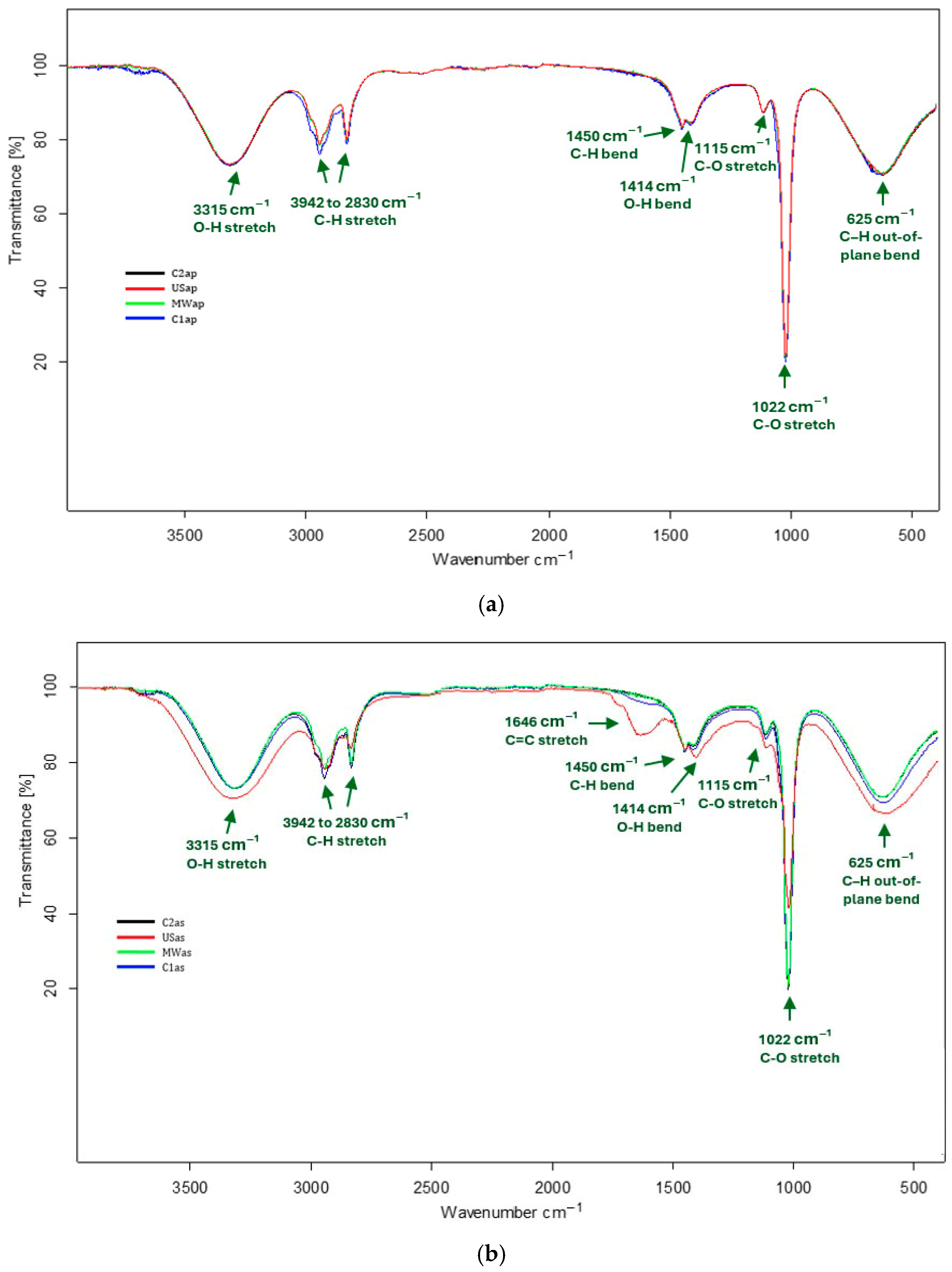
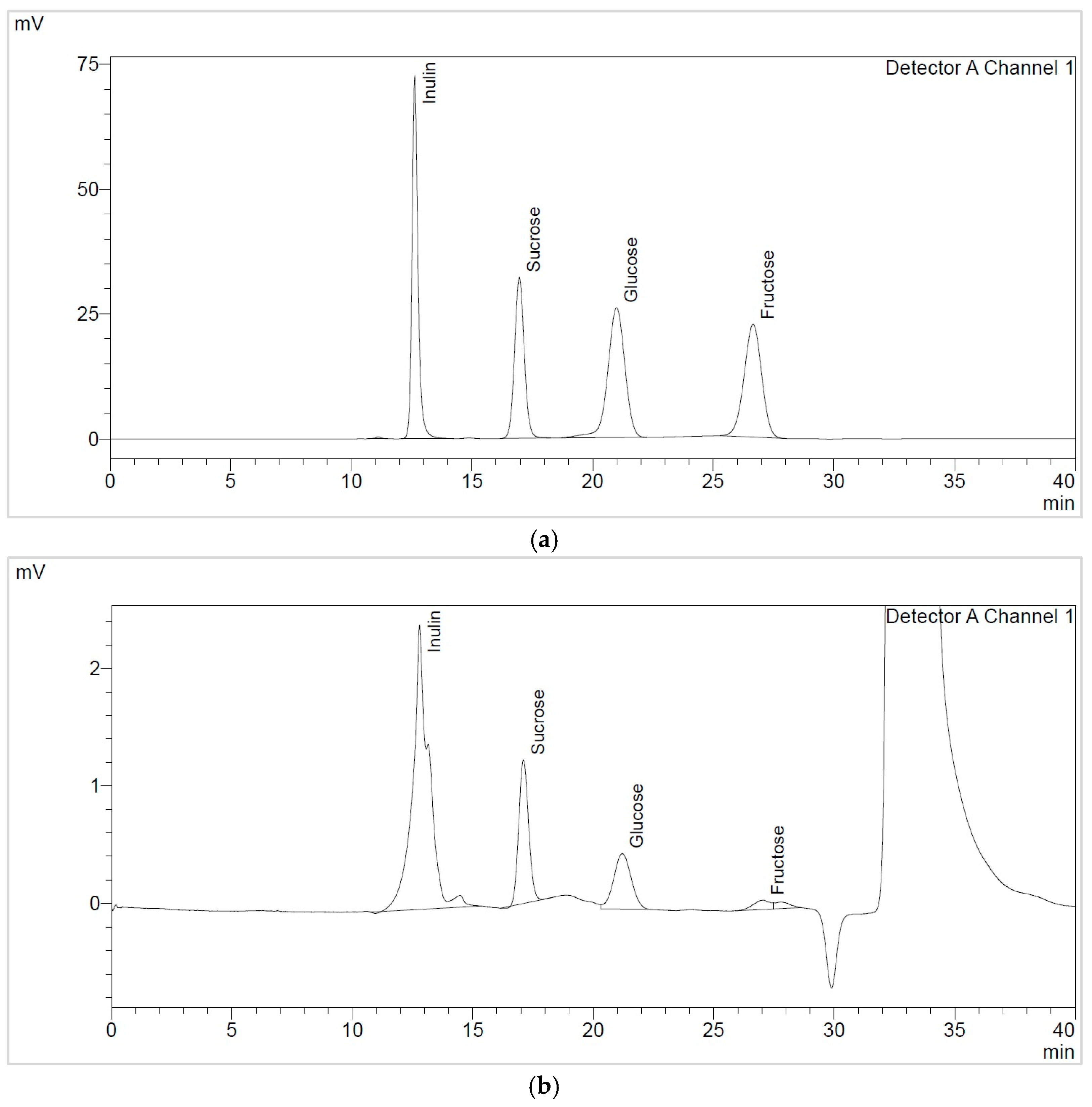
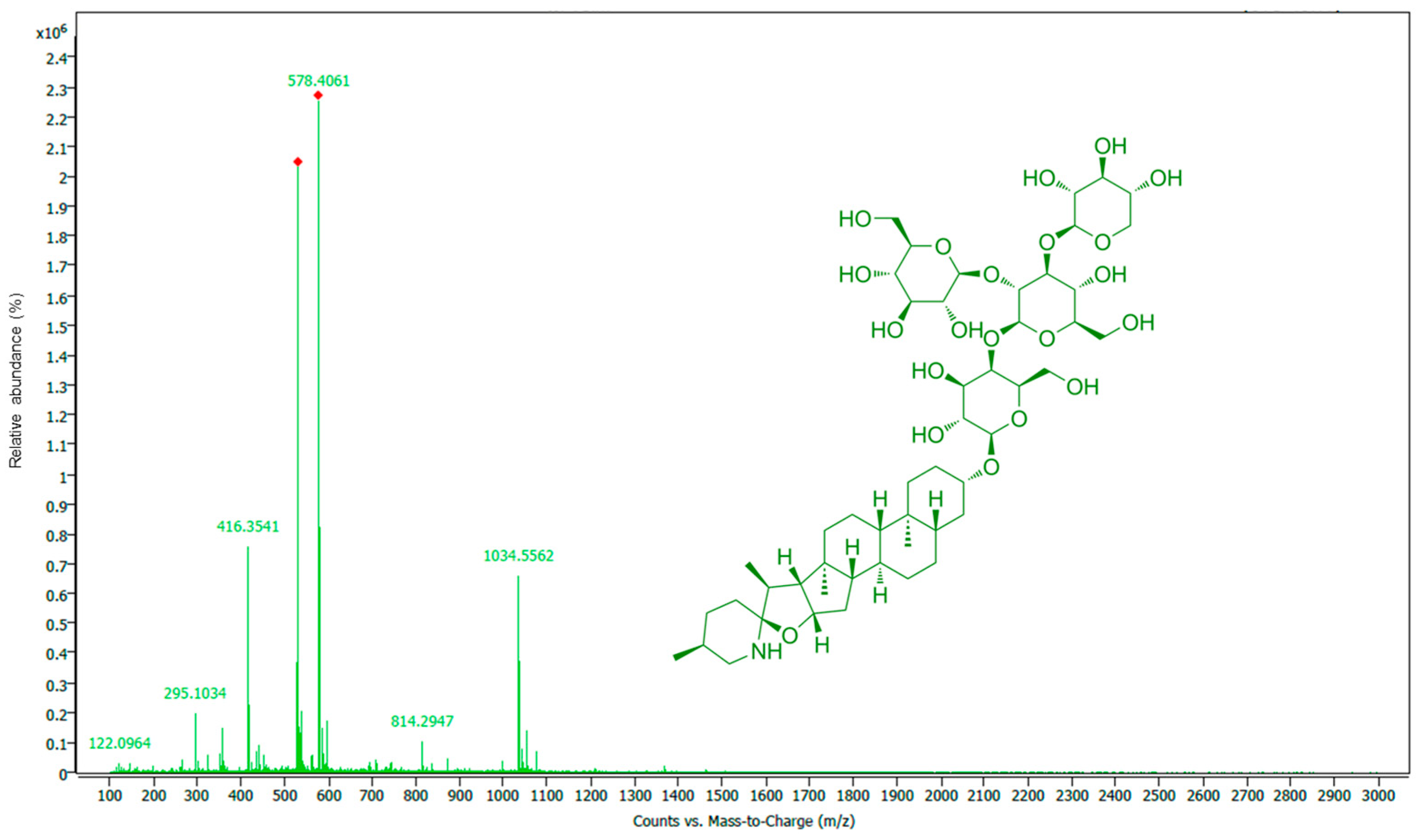
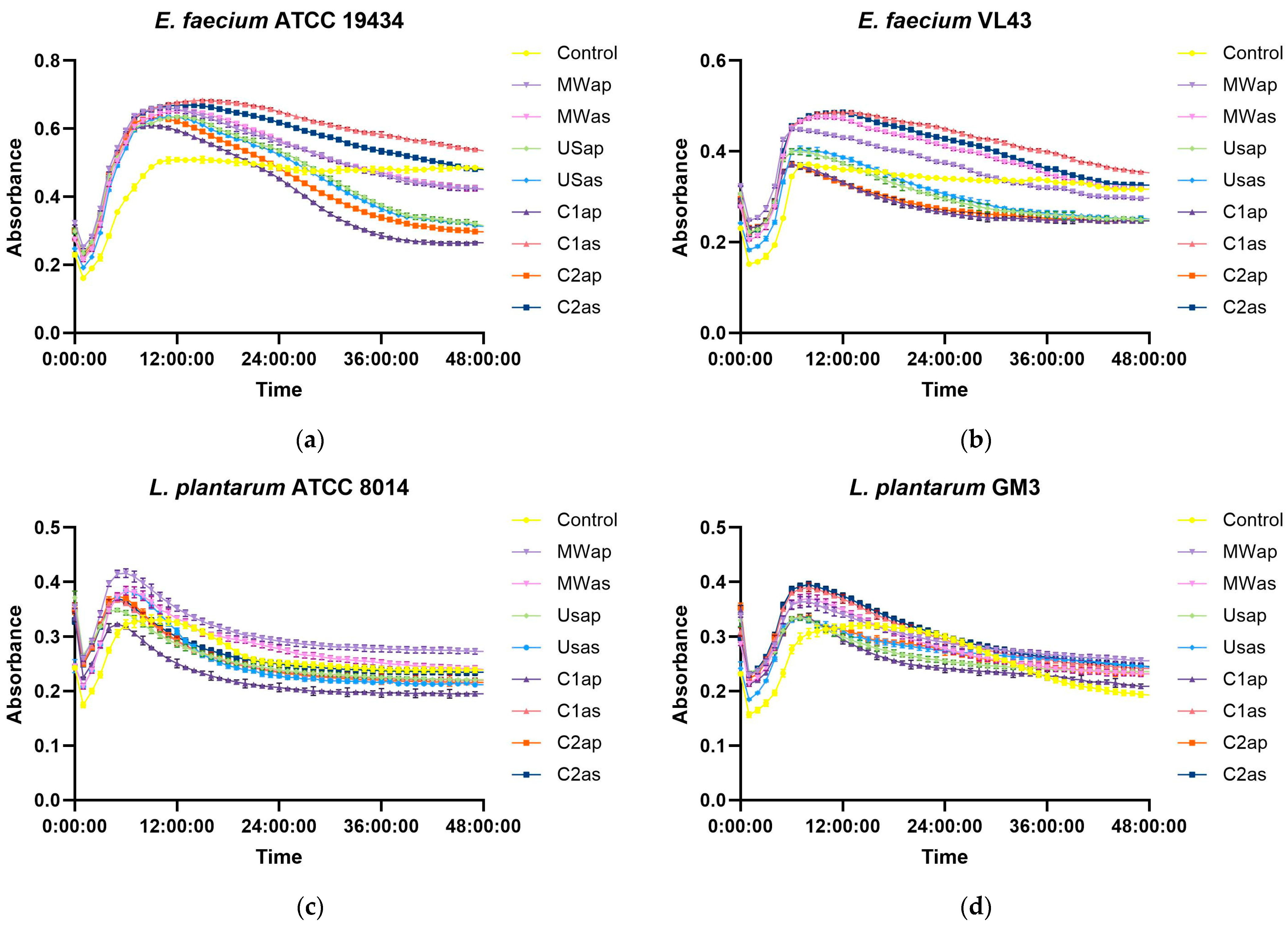
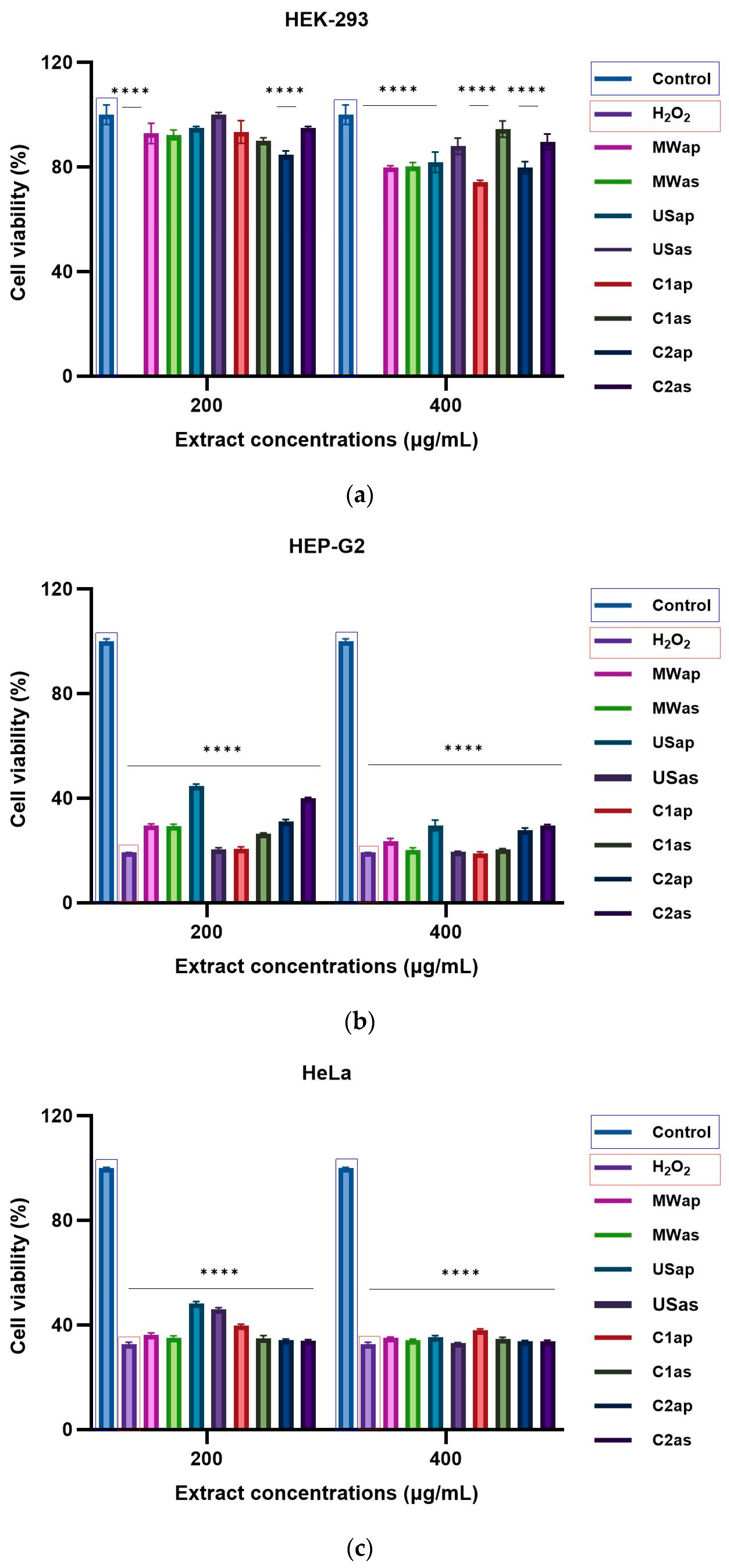


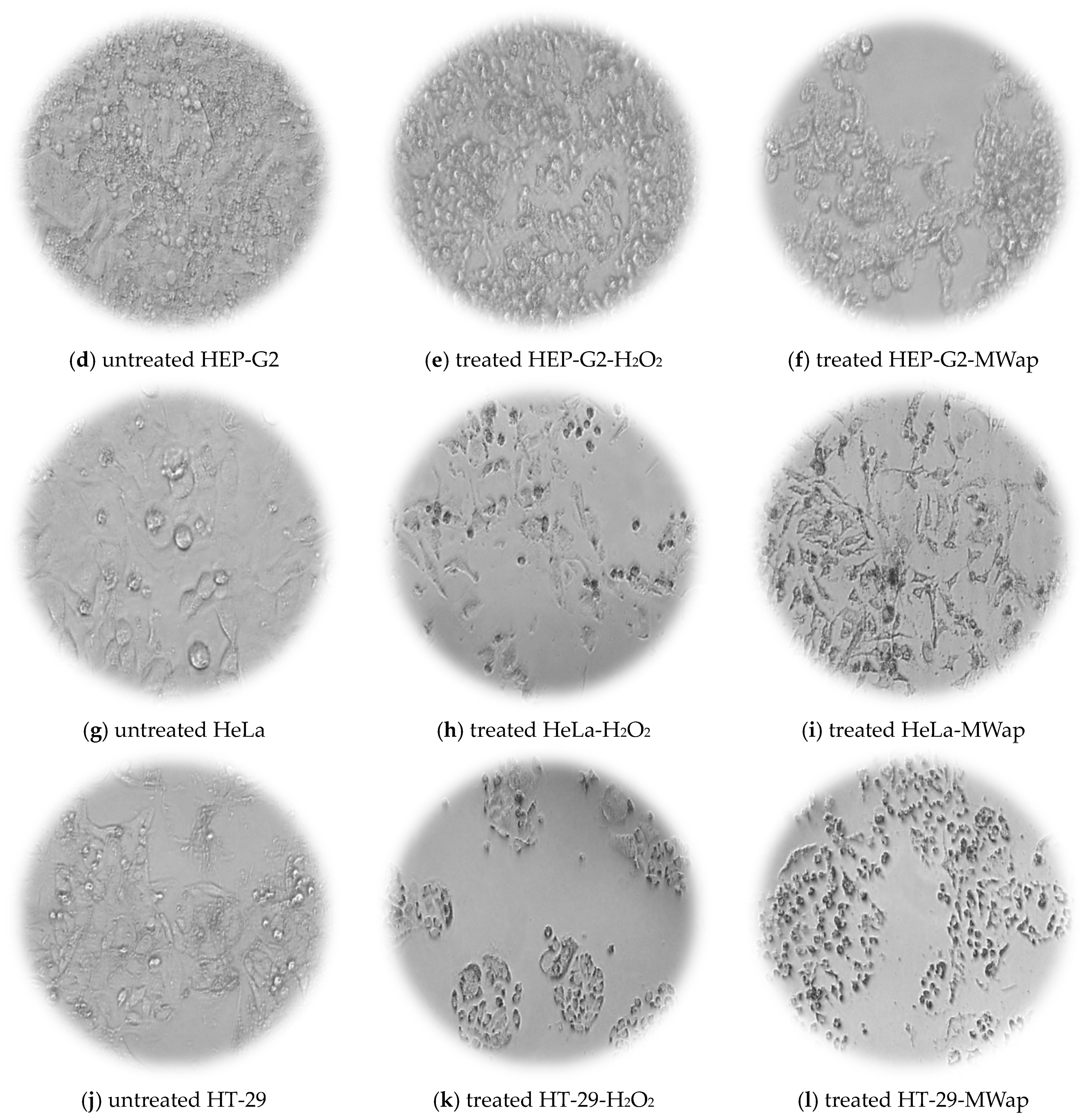
| No. | Extract Code | Part of the Plant | Solvent (%) | Plant: Solvent Ratio | Time (Min) | Temperature (°C) | Extraction Method | Extraction Code |
|---|---|---|---|---|---|---|---|---|
| 1 | MWap | aerial parts mixture (ap) | 78 | 39 | 60 | 79 | microwave- assisted extraction | MAE |
| 2 | MWas | axillary shoots (as) | 73 | 39 | 60 | 125 | ||
| 3 | USap | aerial parts mixture (ap) | 70 | 36 | 60 | 56 | ultrasound- assisted extraction | UAE |
| 4 | USas | axillary shoots (as) | 65 | 40 | 60 | 70 | ||
| 5 | C1ap | aerial parts mixture (ap) | 78 | 39 | 120 | 79 | full-time cascade extraction | CAS1 |
| 6 | C1as | axillary shoots (as) | 73 | 39 | 120 | 125 | ||
| 7 | C2ap | aerial parts mixture (ap) | 78 | 39 | 70 | 79 | short-time cascade extraction | CAS2 |
| 8 | C2as | axillary shoots (as) | 73 | 39 | 70 | 125 |
| RT (min) | Compound Name | RRI | MW | Area (%) |
|---|---|---|---|---|
| 19.98 | Hexyl-methylcyclopentane | 1291 | 168.32 | MWap—0.18; USap—1.21; C2ap—1.10 |
| 26.69 | 3′,5′-Dimethoxyacetophenone | 1567 | 180.20 | USap—1.52 |
| 34.43 | Hexadecatrienoic acid methyl ester | 1904 | 264.41 | USap—0.71; USas—1.96 |
| 35.06 | Palmitic acid, methyl ester | 1934 | 270.46 | MWap—0.79; MWas—16.05; USap—9.39; USas—1.79; C1ap—11.02; C1as—15.77; C2ap—12.83; C2as—13.52 |
| 38.44 | Octadecadienoic acid, methyl ester | 2101 | 294.48 | MWap—0.57; MWas—20.62; USap—6.73; USas—1.78; C1ap—8.76; C1as—19.52; C2ap—9.51; C2as—16.08 |
| 38.54 | Octadecatrienoic acid, methyl ester | 2107 | 292.46 | MWap—1.02; MWas—22.35; USap—13.27; C1ap—15.94; C1as—22.23; C2ap—17.47; C2as—18.80 |
| 38.80 | Phytol | 2119 | 296.54 | MWap—0.90; MWas—13.46; USap—29.70; USas—23.66; C1ap—14.10; C1as—12.77; C2ap—19.89; C2as—16.97 |
| 39.07 | Methyl stearate | 2135 | 298.51 | MWap—0.33; MWas—4.39; USap—3.81; USas -1.94; C1ap—3.05; C1as—4.43; C2ap—4.19; C2as—4.22 |
| 39.99 | Octadecatrienol | 2175 | 264.45 | USap—3.88; USas—4.55 |
| 40.00 | Octadecanamide | 2185 | 283.50 | MWap—0.15; MWas—0.92; C1ap—0.98; C1as—1.15; C2ap—1.94; C2as—1.58 |
| 42.79 | Methyl 18-methylnonadecanoate | 2336 | 326.56 | MWas—1.21 |
| 43.22 | Linoleic acid ethyl ester | 2361 | 306.49 | MWas—1.39 |
| 43.30 | Octadecenamide (Oleamide) | 2367 | 281.48 | MWas—7.59; USap—17.14; USas—29.73; C1ap—8.14; C1as—8.43; C2ap—13.79; C2as—12.10 |
| 43.70 | Nonadecanamide | 2393 | 297.52 | C2ap—2.16 |
| 45.52 | Cyclopropaneoctanoic acid, 2-[[2-[(2-ethylcyclopropyl)methyl]cyclopropyl]methyl]-, methyl ester | 2476 | 334.54 | MWas—2.00; USap—3.45; USas—5.90 |
| 52.04 | 2-Methylhexacosane | 2708 | 380.74 | MWas—0.86; C2as—1.24 |
| Extract Code | Soluble Sugars (mg/g d.e.) | Total (mg/g d.e.) | |||
|---|---|---|---|---|---|
| Sucrose | Glucose | Fructose | Inulin (FOS) | ||
| MWap | 168 ± 1 a | 101 ± 2 a | 21 ± 1 b | 499 ± 6 a | 788 |
| MWas | 44 ± 1 e | 59 ± 1 c | 12 ± 0 e | 345 ± 3 d | 460 |
| USap | 114 ± 3 bc | 73 ± 0 b | 18 ± 1 c | 372 ± 14 c | 577 |
| USas | 45 ± 1 e | 50 ± 1 d | 26 ± 1 a | 377 ± 8 bc | 497 |
| C1ap | 111 ± 7 c | 71 ± 2 b | 16 ± 1 d | 374 ± 5 c | 573 |
| C1as | 42 ± 2 e | 37 ± 0 f | 11 ± 0 e | 327 ± 7 e | 417 |
| C2ap | 119 ± 6 b | 74 ± 3 b | 16 ± 1 d | 392 ± 6 b | 601 |
| C2as | 56 ± 2 d | 46 ± 1 e | 12 ± 1 e | 334 ± 4 de | 448 |
| Alkaloid Name | Molecular Formula | [M+H]+ (m/z) | MS/MS Fragments | References |
|---|---|---|---|---|
| Tomatidine derivative | - | 528.7716 | 416.3530, 257.1902, 122.0963 | [31] |
| α-Tomatine derivative 1 | C39H65NO12 | 743.2025 | 695.3648, 541.2615, 427.1108, 348.1867 | - |
| Dehydrotomatine | C50H81NO21 | 1032.5406 | 922.0105, 755.4210, 576.3910, 414.3375, 246.1136, 163.0420 | [32,33] |
| α-Tomatine | C50H83NO21 | 1034.5562 | 814.2947, 578.4061, 416.3541, 295.1034, 122.0964 | PubChem, [33,34] |
| α-Tomatine derivative 2 | C50H85NO22 | 1051.6212 | 855.5202, 537.3059, 353.2707, 279.2338, 122.0977 | - |
| Acetoxytomatine | C52H85NO23 | 1092.5629 | 1032.5408, 864.4839, 636.4057 557.7672, 414.3281, 295.0930 | [35] |
| α-Tomatine derivative 3 | - | 1197.5930 | 1034.5558, 960.5167, 578.4049, 416.3501, 295.1016 | - |
| α-Tomatine derivative 4 | - | 1237.5882 | 1050.5525, 707.2919, 594.3958, 432.3422, 295.0965, 122.0893 | - |
| α-Tomatine derivative 5 | - | 1292.6559 | 1034.5505, 922.0098, 662.4241, 527.7613, 295.0993, 122.0932 | - |
| α-Tomatine derivative 6 | - | 1363.6905 | 1050.5518, 919.4515, 594.3924, 314.1272, 177.0432 | - |
| α-Tomatine derivative 7 | - | 1367.6250 | 1034.5587, 871.4687, 709.4112, 578.3980, 416.3424, 295.0912 | - |
| Candida Species | TPW Extract | |||||||
|---|---|---|---|---|---|---|---|---|
| MWap | MWas | USap | USas | C1ap | C1as | C2ap | C2as | |
| C. albicans ATCC 10231 | + | ++ | + | +++ | + | ++ | + | ++ |
| C. albicans CMGBy 18 | + | + | + | + | + | + | + | + |
| C. parapsilosis ATCC 22019 | +/− | ++ | +/− | ++ | +/− | + | +/− | ++ |
| C. glabrata ATCC 64677 | +++ | +++ | ++ | +++ | +++ | +++ | ++ | +++ |
| C. auris DSM 21092 | +/− | +/− | +/− | +/− | +/− | +/− | +/− | +/− |
| C. auris 6328 | +/− | +/− | +/− | +/− | +/− | +/− | +/− | +/− |
| Candida Species | TPW Extract (µg/mL) | FLU (µg/mL) | |||||||
|---|---|---|---|---|---|---|---|---|---|
| MWap | MWas | USap | USas | C1ap | C1as | C2ap | C2as | ||
| C. albicans ATCC 10231 | 1000 | 250 | 1000 | 250 | 500 | 250 | 500 | 250 | 15 |
| C. parapsilosis ATCC 22019 | 1000 | 250 | 1000 | 250 | 1000 | 500 | 1000 | 250 | 31 |
| C. glabrata ATCC 64677 | 125 | 125 | 250 | 125 | 125 | 125 | 250 | 125 | 50 |
| C. auris 6328 | 1000 | 1000 | 1000 | 1000 | 1000 | 1000 | 1000 | 1000 | <100 |
Disclaimer/Publisher’s Note: The statements, opinions and data contained in all publications are solely those of the individual author(s) and contributor(s) and not of MDPI and/or the editor(s). MDPI and/or the editor(s) disclaim responsibility for any injury to people or property resulting from any ideas, methods, instructions or products referred to in the content. |
© 2025 by the authors. Licensee MDPI, Basel, Switzerland. This article is an open access article distributed under the terms and conditions of the Creative Commons Attribution (CC BY) license (https://creativecommons.org/licenses/by/4.0/).
Share and Cite
Marcu Spinu, S.; Dragoi Cudalbeanu, M.; Cimpeanu, C.L.; Major, N.; Sieniawska, E.; Wojtanowski, K.K.; Avram, I.; Pelinescu, D.; Ortan, A.; Babeanu, N.E. In Vitro Insights into the Antifungal, Prebiotic, and Cytotoxic Potential of Tomato Plant Waste. Nutrients 2025, 17, 3616. https://doi.org/10.3390/nu17223616
Marcu Spinu S, Dragoi Cudalbeanu M, Cimpeanu CL, Major N, Sieniawska E, Wojtanowski KK, Avram I, Pelinescu D, Ortan A, Babeanu NE. In Vitro Insights into the Antifungal, Prebiotic, and Cytotoxic Potential of Tomato Plant Waste. Nutrients. 2025; 17(22):3616. https://doi.org/10.3390/nu17223616
Chicago/Turabian StyleMarcu Spinu, Simona, Mihaela Dragoi Cudalbeanu, Carmen Laura Cimpeanu, Nikola Major, Elwira Sieniawska, Krzysztof Kamil Wojtanowski, Ionela Avram, Diana Pelinescu, Alina Ortan, and Narcisa Elena Babeanu. 2025. "In Vitro Insights into the Antifungal, Prebiotic, and Cytotoxic Potential of Tomato Plant Waste" Nutrients 17, no. 22: 3616. https://doi.org/10.3390/nu17223616
APA StyleMarcu Spinu, S., Dragoi Cudalbeanu, M., Cimpeanu, C. L., Major, N., Sieniawska, E., Wojtanowski, K. K., Avram, I., Pelinescu, D., Ortan, A., & Babeanu, N. E. (2025). In Vitro Insights into the Antifungal, Prebiotic, and Cytotoxic Potential of Tomato Plant Waste. Nutrients, 17(22), 3616. https://doi.org/10.3390/nu17223616








